How to Connect to TV via HDMI port
Connect a standard HDMI device
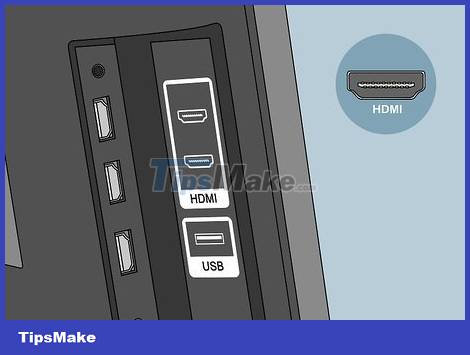
Locate an available HDMI port on the TV. Most TVs today have at least one standard-sized HDMI port (Type A) with specifications of 13.9 mm x 4.45 mm. These ports are often labeled as "HDMI". If there are multiple ports, each port will be numbered (for example, HDMI 1 , HDMI 2 ).
Some TVs also have HDMI ports on the front or side.
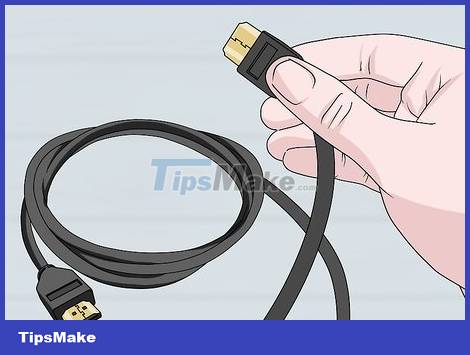
Choose the right HDMI cable. If your device has an HDMI port the same size as your TV (Type A/13.99 mm x 4.45 mm), you only need a standard HDMI Type A cable with the same 19 pins on both ends. However, some devices (usually cameras and portable media players) have smaller HDMI ports, which means we need a different type of cable:
Type C/Mini-HDMI: This type of HDMI port is often found on older DSLR cameras and camcorders. The port measures 10.42 mm x 2.42 mm and is much smaller than a Type A port. If your device has this port, you will need a Mini-HDMI-C to HDMI-A cable .
Type D/Micro-HDMI: This port is even smaller than Type C, measuring only 6.4 mm x 2.8 mm and is often found on small recording devices such as GoPro or some smartphones. In this case, we need a Micro HDMI-D to HDMI-A cable .
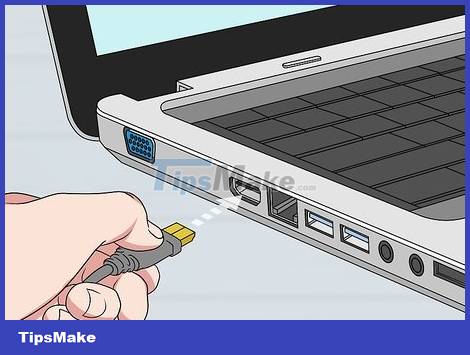
Connect one end of the cable to the device. Turn on the device you want to connect to the TV, then gently insert the appropriate cable end into the HDMI port on the device.
We can only plug the HDMI cable into the port in one direction. Never attempt to insert the cable end into a port, as this may damage both the cable and the device.
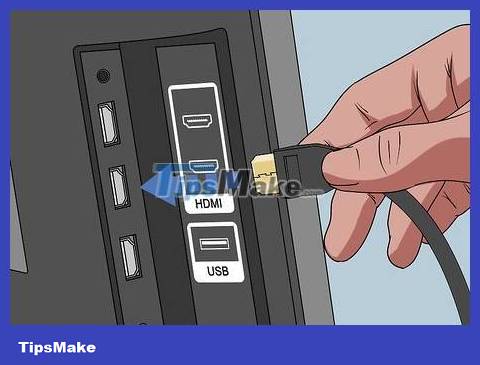
Plug the other end of the cable into the TV. If the TV is off, turn it on and connect the cable properly. If your TV has multiple HDMI ports, you'll need to write down the number of the HDMI port you're using.
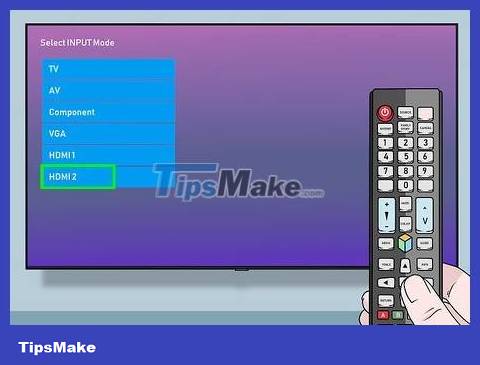
Switch to the HDMI source on the TV. Use the SOURCE or INPUT button on the remote control or TV to select the HDMI port. Usually we need to press a few times until we get to the correct port number. When you open it to the appropriate source, the device's image will appear on the screen.
On Windows, press ⊞ Win+ Pto open the Windows Project panel, then select the option to show screen on TV. For example, if you want to project your desktop screen to the TV, select Duplicate .
On Mac, the screen is automatically projected to the TV. If the size looks unbalanced, you can open Apple menu > System Preferences > Displays > Display and select Default for display . If you want to enter a specific resolution, select Scaled and type in the size.
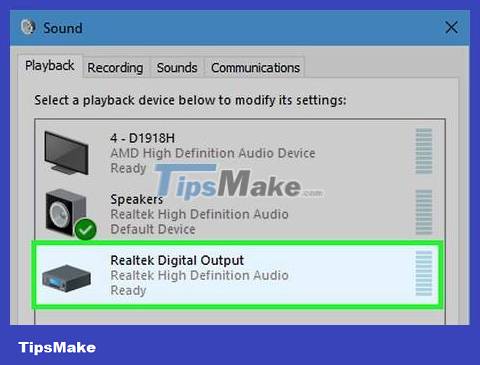
Configure your computer's audio to play through the TV (optional). If you've connected your computer to your TV and want to make sure that sound plays through the TV's speakers, proceed as follows:
On Mac : Go to Apple menu > System Preferences > Sound > Output and select TV or HDMI output .
On Windows: Right-click the sound icon in the system tray (next to the clock), select Sound Settings and select your computer's default audio device with the usual name Speakers (High Definition Audio). ) from the "Choose your output device" menu.
Connect a device without an HDMI port to the TV's HDMI port
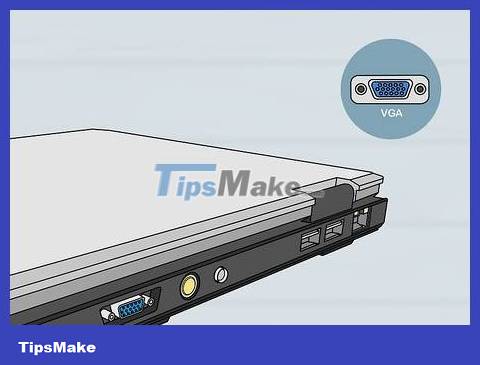
Identify the HDMI-compatible port on the device. If your TV has an HDMI port and your game console, computer or other electronic device does not, you can still connect a device that converts the given port to an HDMI Type A (standard) connector. You can find HDMI cables/converters for the following port types:
DisplayPort: This type of port, after converting to HDMI, can support both high-resolution video and digital audio. The label on the port will denote "DP" or "DisplayPort". If your laptop or tablet uses a DisplayPort port, you will need a DisplayPort-to-HDMI-A cable or converter.
Some devices, including the Microsoft Surface, have a Mini DisplayPort port instead of the standard size. In this case, you will need a DisplayPort Mini-to-HDMI-A cable or an adapter.
DVI: The DVI port does not support audio transmission, but you can transmit high-quality video if you use a DVI-to-HDMI-A cable or converter. Note: DVI ports come in many different sizes, so you need to use the appropriate cable. Count the number of pins in the DVI port and compare it with the pin number of the existing cable and converter.
VGA: With the VGA port commonly found on older devices, it will be difficult for you to experience the best picture quality on the TV and of course there is no sound. However, you can still connect to the device using a VGA-to-HDMI-A converter/adapter .
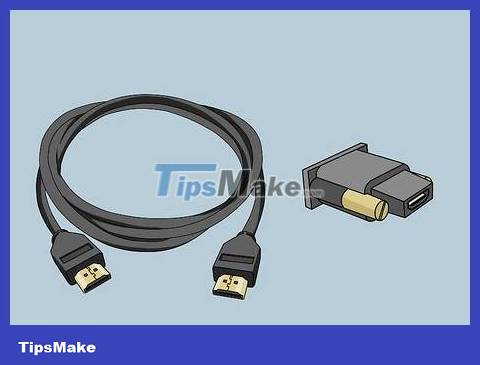
Select the appropriate cable or adapter.
Most TVs today have at least one HDMI port (Type A) standard size 13.9 mm x 4.45 mm. You can easily find cables that have an HDMI-A connector with a DVI, DisplayPort, or VGA connector on the other end. Then you just need to make sure the non-HDMI plug fits into the port on the device.
Another option for you is to buy a smaller adapter/converter. With an adapter, you need to plug a standard HDMI cable into the HDMI port and a standard DVI, DisplayPort or VGA cable into the other end of the adapter. This means you will need two different cables plugged into one adapter.
The HDMI cable must be long enough to connect the device to the TV. Choose a slightly longer cord than is practical to minimize strain on the cable and both devices.
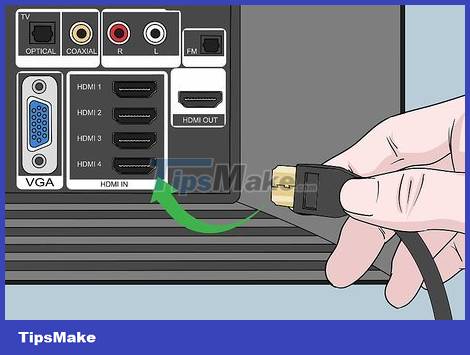
Plug the HDMI-A end into the port on the TV. Turn on the TV if the device is not already turned on, then connect the cable properly. If your TV has multiple HDMI ports, you'll need to write down the number of the HDMI port you're using.
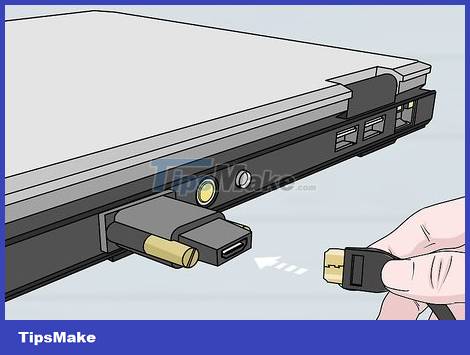
Plug the other end of the cable into the device or adapter. If using an HDMI-to- (other standard) cable , plug the appropriate end into that port. If you buy an adapter, plug the HDMI cable end into the HDMI side of the adapter, then connect the adapter to the device using the corresponding cable (DVI, DisplayPort or VGA) for the device.
Do not try to insert the cable end into the port. The cable only plugs in one way, and if you have difficulty, this type of cable may not be suitable.
If you use an adapter for the VGA port, you will need to plug in the adapter head according to the color corresponding to the video and audio ports on the computer.
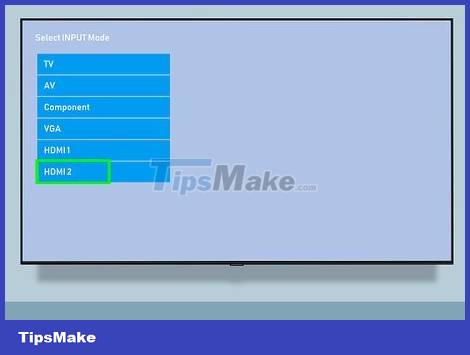
Switch to the HDMI source on the TV. First, turn on the device without an HDMI port and use the SOURCE or INPUT button on the TV/remote to select the HDMI port. Usually you need to press a few times for the TV to go to the appropriate port number. When you open the correct HDMI port, the device's icon will appear on the screen.
On Windows, press ⊞ Win+ Pto open the Windows Project panel, then select the option to show screen on TV. For example, if you want to project your desktop screen to the TV, select Duplicate .
On Mac, the screen is automatically projected to the TV. If the size looks unbalanced, you can open Apple menu > System Preferences > Displays > Display and select Default for display . If you want to enter a specific resolution, select Scaled and type in the size.

Connect separate audio if necessary. If you don't use DisplayPort, you'll need to use a separate cable to output sound through the TV.
If both the input device and the TV have appropriate ports, you can connect the two devices directly using separate stereo cables.
Or you can use an audio cable to redirect sound from the input device to a nearby speaker system that is already connected to the TV.
You should read it
- What is the HDMI (ARC) port on TV used for?
- How to Connect HDMI to TV
- How to fix some errors connecting TV to laptop via HDMI port
- How to connect laptop to TV via HDMI port
- What is HDMI? Instructions for connecting devices via HDMI port
- What is HDMI ARC port? Functions and connection methods
- How to Connect PC to TV with HDMI
- Instructions on how to connect a laptop to a TV via HDMI are very simple
May be interested
- 5 ways to make use of spare HDMI ports
 many new graphics cards and monitors today prioritize the use of displayport (dp) connections, leaving the hdmi port on many motherboards empty.
many new graphics cards and monitors today prioritize the use of displayport (dp) connections, leaving the hdmi port on many motherboards empty. - How to Connect an HDMI Cable
 hdmi (high definition multimedia interface) is an audio/video device connection standard. it replaces older connection methods such as combo port or s-video. hdmi transmits digital signals and can process both audio and video signals. hdmi is the simplest way to connect multiple t
hdmi (high definition multimedia interface) is an audio/video device connection standard. it replaces older connection methods such as combo port or s-video. hdmi transmits digital signals and can process both audio and video signals. hdmi is the simplest way to connect multiple t - Instructions on how to connect a laptop to a TV via HDMI are very simple
 currently, there are many ways to share multimedia content and share via hdmi is the fastest and most convenient way but still not known by many people.
currently, there are many ways to share multimedia content and share via hdmi is the fastest and most convenient way but still not known by many people. - How to Connect PC to TV via HDMI
 tipsmake today will show you how to connect your pc to your tv using an hdmi cable. when you connect your pc to your tv, you will be able to project your computer screen on your tv and watch movies or browse the internet on the big screen. all you need is to connect the two devices using an hdmi cable.
tipsmake today will show you how to connect your pc to your tv using an hdmi cable. when you connect your pc to your tv, you will be able to project your computer screen on your tv and watch movies or browse the internet on the big screen. all you need is to connect the two devices using an hdmi cable. - How to Connect Roku to TV
 this wikihow teaches you how to install, set up, and activate a roku streaming player or stick on your hdtv. determine your roku type. there are two main types of roku, both of which will require your tv to have at least one hdmi port to...
this wikihow teaches you how to install, set up, and activate a roku streaming player or stick on your hdtv. determine your roku type. there are two main types of roku, both of which will require your tv to have at least one hdmi port to... - How to Connect a DVD Player to a Laptop
 this tipsmake will teach you how to connect a dvd player to your laptop using an hdmi cable. you can also purchase an external dvd drive and connect it to your laptop via usb, but you will need a movie-playing program like vlc to play it....
this tipsmake will teach you how to connect a dvd player to your laptop using an hdmi cable. you can also purchase an external dvd drive and connect it to your laptop via usb, but you will need a movie-playing program like vlc to play it.... - Should I use HDTV instead of a computer monitor?
 the biggest factor deciding whether hdtv can be used on a computer is the purpose of using the pc. there are many different uses, but most of us often use pc in daily activities, or entertainment.
the biggest factor deciding whether hdtv can be used on a computer is the purpose of using the pc. there are many different uses, but most of us often use pc in daily activities, or entertainment. - How to connect printer 2.0 USB port to USB 3.0 port on Windows 10
 the following article will guide you how to connect the usb 2.0 port of the printer to the usb 3.0 port on your computer. if you are having a similar problem, try it now!
the following article will guide you how to connect the usb 2.0 port of the printer to the usb 3.0 port on your computer. if you are having a similar problem, try it now! - How to Connect HDMI Cables
 this wikihow teaches you how to use hdmi cables to connect computers, entertainment systems, and game consoles to tvs. hdmi allows you to quickly connect your electronic devices without having to fumble with color-coded cables or multiple...
this wikihow teaches you how to use hdmi cables to connect computers, entertainment systems, and game consoles to tvs. hdmi allows you to quickly connect your electronic devices without having to fumble with color-coded cables or multiple... - What is DVI port? Classification of popular DVI ports today
 the dvi port is considered a popular connection port, but many people still cannot distinguish this type of port from hdmi, dvi or vga. click to learn more.
the dvi port is considered a popular connection port, but many people still cannot distinguish this type of port from hdmi, dvi or vga. click to learn more.










 How to Remove a TV from a Mount
How to Remove a TV from a Mount How to Use Apple TV
How to Use Apple TV How to Play VOB Files
How to Play VOB Files How to Connect Kindle Fire to TV
How to Connect Kindle Fire to TV How to Connect Coaxial Cable Ends
How to Connect Coaxial Cable Ends How to Install a DVD Player
How to Install a DVD Player